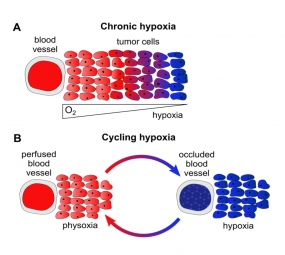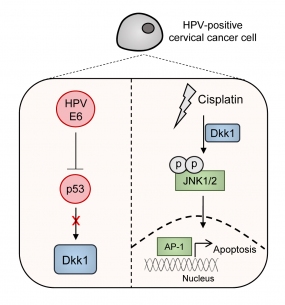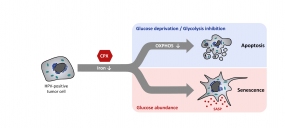Human Papillomavirus (HPV)-Induced Carcinogenesis
Key words: tumor viruses, human papillomavirus (HPV), cervical cancer, transformation mechanisms, hypoxia, cancer therapy, metabolism, senescence, apoptosis, signal transduction
Human papillomaviruses are major human carcinogens and closely linked to 5% of the total cancer incidence in humans, including cervical cancer and head & neck cancer (HNSCC). Our work aims to understand the molecular basis of HPV-linked carcinogenesis and to identify novel therapeutic options for cancer treatment (Hoppe-Seyler et al., 2018).
1. Chronic and Cycling Hypoxia

Fig. 1. Chronic and cycling hypoxia. (A) Chronic hypoxia is often diffusion-limited. Tumor cells which are remote from tumor blood vessels are inadequately supplied with O2 and become hypoxic. Red: Oyxgenated tumor cells, blue: hypoxic tumor cells. (B) Cycling hypoxia is often perfusion-limited. Tumor vessels are typically abnormally structured and can be temporarily occluded, e.g., through blood cell aggregates. Due to the repeated closure and re-opening of tumor vessels, surrounding tumor cells are exposed to fluctuating cycles of physoxia (left) and hypoxia (right) (from Hoppe-Seyler et al., 2017a).
Many solid tumors contain regions of low oxygen concentrations ("hypoxia"). Hypoxia critically determines the clinical behaviour of cancers and is typically linked to increased resistance against chemo- and radiotherapy (Hoppe-Seyler et al., 2017a). We thus are interested to functionally study the role of hypoxia for the malignant phenotype and the therapeutic resistance of HPV-positive cancer cells.
We uncovered that HPV-positive cancer cells exposed to chronic hypoxia induce a state of dormancy, characterized by viral oncogene repression and a reversible growth arrest. This response could contribute to therapy resistance, immune evasion and tumor recurrence (Hoppe-Seyler et al., 2017b) (Press release DKFZ). Mechanistically, we showed that hypoxia provides resistance to pro-senescent chemotherapy via interference with mTORC1 signaling (Hoppe-Seyler et al., 2017b). Further, we identified active PI3K/AKT signaling as being critical for mediating the hypoxic repression of the HPV E6/E7 oncogenes (Bossler et al., 2019a, 2019b).
Ongoing studies aim to identify possible strategies to counteract the resistance of hypoxic tumor cells to chemo- and radiotherapy, which is a major problem for cancer therapy in the clinic. In addition, we extended our investigations to a second major form of hypoxia in cancers, cycling hypoxia (Fig. 1), which could play a particularly important role for the malignant growth and the therapeutic resistance of tumor cells.
2. Molecular Basis of Cervical Cancer

Fig. 2. DKK1 is a critical determinant for the sensitivity of cervical cancer cells towards Cisplatin. The levels of the cellular Dkk1 protein are restricted in HPV-positive tumor cells by the HPV E6 oncoprotein via its interference with p53. Dkk1 plays a key role for the anti-cancer activity of Cisplatin by enabling efficient stimulation of pro-apoptotic JNK/AP1 signaling (from Frensemeier et al., 2022).
With the overall aims to improve our understanding of cervical carcinogenesis and to discover novel therapeutic targets, we are interested in identifying factors, which determine the malignant phenotype of cervical cancer cells. We recently uncovered that the levels of the cellular Dickkopf-1 (Dkk1) protein are under negative control by the HPV E6 oncoprotein. Notably, Dkk1 plays a key role for promoting efficient apoptosis induction by Cisplatin (Frensemeier et al., 2022), which is a key drug for the clinical management of cervical cancer. Mechanistic studies revealed that Dkk1 is important the induction of pro-apoptotic JNK (c-Jun N-terminal kinase)/AP1 signaling by Cisplatin (Fig. 2).
Ongoing work studies the role of two additional cellular proteins, FAM57A (Yang et al, 2022) and STAT3, for the malignant phenotype of cervical cancer cells and their potential to serve as therapeutic targets.
3. Metabolic Drugs

Fig. 3. The iron chelator Ciclopirox (CPX) acts anti-proliferative in cervical cancer cells (Braun et al., 2020). Under limited glucose supply, CPX induces apoptosis through its ability to block oxidative phosphorylation (OXPHOS). At increased glucose supply, the cells react with the induction of cellular senescence (Herrmann et al., 2021). The phenotypic switch between apoptosis or senescence - which is also seen for established chemotherapeutic drugs - may affect therapy outcome (Fig. from Herrmann et al., 2021).
We investigate the phenotypic effects and therapeutic potential of metabolic drugs, such as the anti-fungal agent Ciclopirox, an iron chelator (Fig. 3), or the anti-diabetic agent Metformin, an inhibitor of oxidative phosphorylation (OXPHOS). Interestingly, both drugs efficiently block HPV oncogene expression and act anti-proliferative in cervical cancer cells. Both drugs also modulate the apoptosis and senescence response in HPV-positive tumor cells, and can cooperate with chemo- and radiotherapy under certain conditions (Braun et al., 2020; Hoppe-Seyler et al., 2021; Herrmann et al., 2021). Ongoing work aims at exploring the molecular mechanisms underlying senescence and apoptosis regulation by these agents, also in combination with chemo- and radiotherapy.
Our work is supported by the Wilhelm Sander-Stiftung, the Deutsche Krebshilfe, the Dr. Rolf M. Schwiete Stiftung and the Deutsche Akademische Austauschdienst (DAAD).
All figures © dkfz.de.
